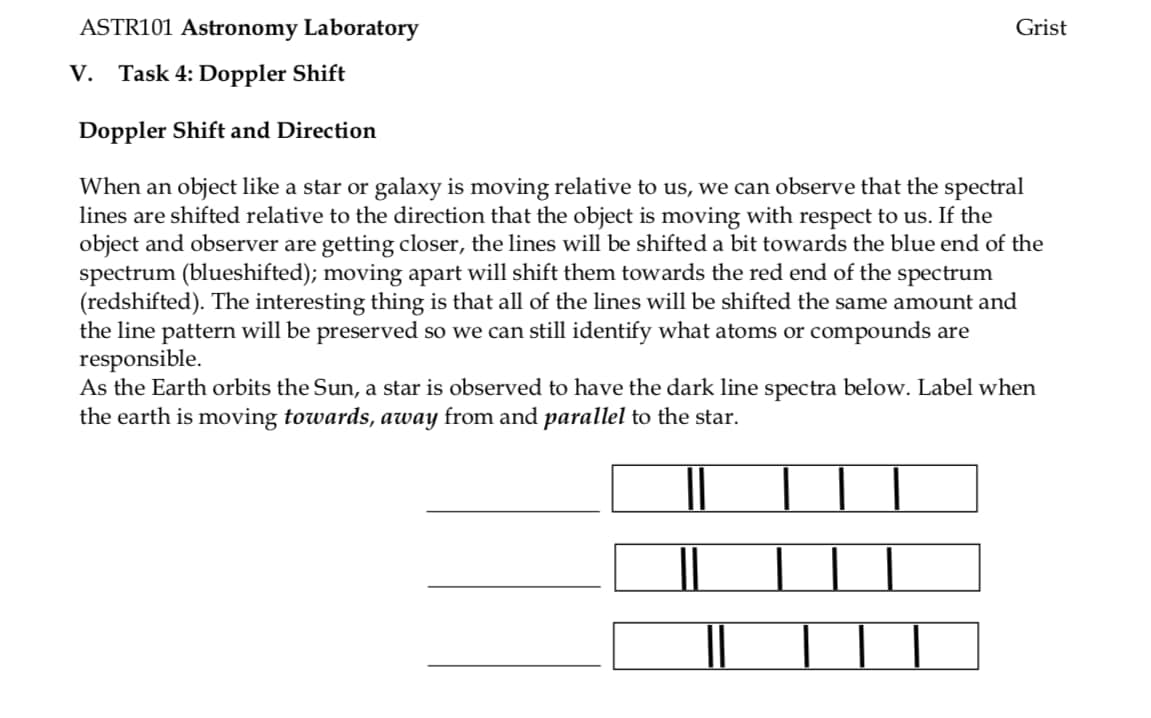When an object like a star or galaxy is moving relative to us, we can observe that the spectral lines are shifted relative to the direction that the object is moving with respect to us. If the object and observer are getting closer, the lines will be shifted a bit towards the blue end of the spectrum (blueshifted); moving apart will shift them towards the red end of the spectrum (redshifted). The interesting thing is that all of the lines will be shifted the same amount and the line pattern will be preserved so we can still identify what atoms or compounds are responsible. As the Earth orbits the Sun, a star is observed to have the dark line spectra below. Label when the earth is moving towards, away from and parallel to the star.
When an object like a star or galaxy is moving relative to us, we can observe that the spectral lines are shifted relative to the direction that the object is moving with respect to us. If the object and observer are getting closer, the lines will be shifted a bit towards the blue end of the spectrum (blueshifted); moving apart will shift them towards the red end of the spectrum (redshifted). The interesting thing is that all of the lines will be shifted the same amount and the line pattern will be preserved so we can still identify what atoms or compounds are responsible. As the Earth orbits the Sun, a star is observed to have the dark line spectra below. Label when the earth is moving towards, away from and parallel to the star.
Applications and Investigations in Earth Science (9th Edition)
9th Edition
ISBN:9780134746241
Author:Edward J. Tarbuck, Frederick K. Lutgens, Dennis G. Tasa
Publisher:Edward J. Tarbuck, Frederick K. Lutgens, Dennis G. Tasa
Chapter1: The Study Of Minerals
Section: Chapter Questions
Problem 1LR
Related questions
Question

Transcribed Image Text:ASTR101 Astronomy Laboratory
V. Task 4: Doppler Shift
Doppler Shift and Direction
Grist
When an object like a star or galaxy is moving relative to us, we can observe that the spectral
lines are shifted relative to the direction that the object is moving with respect to us. If the
object and observer are getting closer, the lines will be shifted a bit towards the blue end of the
spectrum (blueshifted); moving apart will shift them towards the red end of the spectrum
(redshifted). The interesting thing is that all of the lines will be shifted the same amount and
the line pattern will be preserved so we can still identify what atoms or compounds are
responsible.
As the Earth orbits the Sun, a star is observed to have the dark line spectra below. Label when
the earth is moving towards, away from and parallel to the star.
Expert Solution
This question has been solved!
Explore an expertly crafted, step-by-step solution for a thorough understanding of key concepts.
Step by step
Solved in 3 steps

Recommended textbooks for you

Applications and Investigations in Earth Science …
Earth Science
ISBN:
9780134746241
Author:
Edward J. Tarbuck, Frederick K. Lutgens, Dennis G. Tasa
Publisher:
PEARSON

Exercises for Weather & Climate (9th Edition)
Earth Science
ISBN:
9780134041360
Author:
Greg Carbone
Publisher:
PEARSON

Environmental Science
Earth Science
ISBN:
9781260153125
Author:
William P Cunningham Prof., Mary Ann Cunningham Professor
Publisher:
McGraw-Hill Education

Applications and Investigations in Earth Science …
Earth Science
ISBN:
9780134746241
Author:
Edward J. Tarbuck, Frederick K. Lutgens, Dennis G. Tasa
Publisher:
PEARSON

Exercises for Weather & Climate (9th Edition)
Earth Science
ISBN:
9780134041360
Author:
Greg Carbone
Publisher:
PEARSON

Environmental Science
Earth Science
ISBN:
9781260153125
Author:
William P Cunningham Prof., Mary Ann Cunningham Professor
Publisher:
McGraw-Hill Education

Earth Science (15th Edition)
Earth Science
ISBN:
9780134543536
Author:
Edward J. Tarbuck, Frederick K. Lutgens, Dennis G. Tasa
Publisher:
PEARSON

Environmental Science (MindTap Course List)
Earth Science
ISBN:
9781337569613
Author:
G. Tyler Miller, Scott Spoolman
Publisher:
Cengage Learning

Physical Geology
Earth Science
ISBN:
9781259916823
Author:
Plummer, Charles C., CARLSON, Diane H., Hammersley, Lisa
Publisher:
Mcgraw-hill Education,